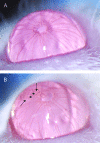Evaluation of a Synthetic Bedding Substrate for Mice (Mus musculus)
- PMID: 30803467
- PMCID: PMC6433361
- DOI: 10.30802/AALAS-JAALAS-18-000075
Evaluation of a Synthetic Bedding Substrate for Mice (Mus musculus)
Abstract
This study compared a synthetic bedding substrate (SBS), which has the potential to be a particulate-free animal bedding system, with the standard woodchip bedding. The objective was to demonstrate that the SBS is habitable for mice and reduces particulates to levels that would not contaminate the eye or potentially induce ocular (corneal) injury. Newly weaned mice were placed in either standard woodchip bedding or SBS. All mice were monitored regarding overall health (appearance, food and water intake, natural behavior, clinical signs, and provoked behavior) to verify their ability to adjust to the bedding. At 8 to 10 wk of age, the mice underwent slit-lamp evaluation for ocular (corneal) abnormalities. Results showed significant differences in body weight and overall health between bedding groups. The incidence of ocular abnormalities did not differ significantly between groups. We conclude that, without modifications and more testing, SBS is not a favorable bedding for mice, and results were inconclusive regarding its use as a bedding to preclude ocular contamination.
Figures





References
-
- Bazille PG, Walden SD, Koniar BL, Gunther R. 2001. Commercial cotton nesting material as a predisposing factor for conjunctivitis in athymic nude mice. Lab Anim (NY) 30:40–42. - PubMed
-
- Centers for Disease Control and Prevention. [Internet]. 2016. NIOSH pocket guide to chemical hazards. Washington (DC): Government Printing Office; [Cited 04 February 2018]. Available at: https://www.cdc.gov/niosh/npg/npgd0028.html
Publication types
MeSH terms
Substances
LinkOut - more resources
Full Text Sources

